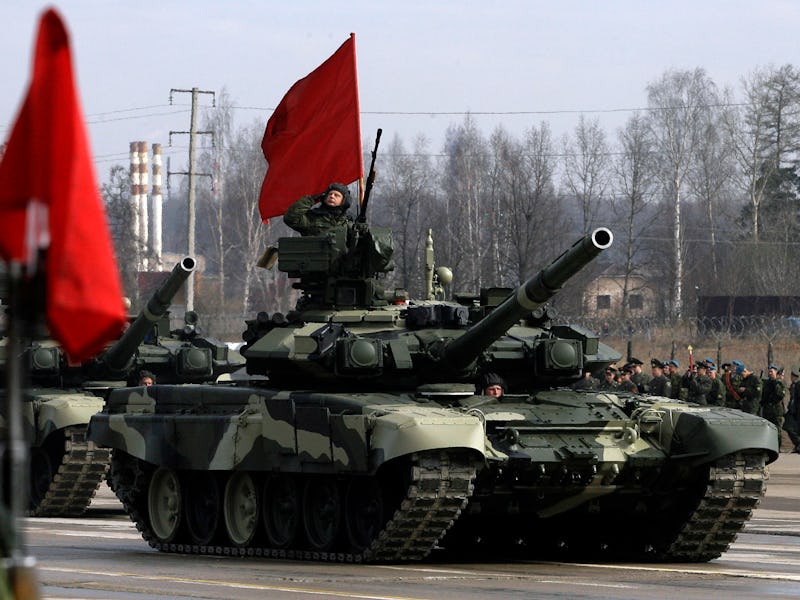The 5 Russian Weapons Likely to Be Used in a Global War
They could be unlike anything the world has seen before.

The Russian military is formidable, but it can’t compete with the combined forces of the United States and its NATO allies on material strength alone. That’s why Russia has been investing in weapons that will let it conduct asymmetrical warfare, a combined attack on the physical, digital, and even cultural strength of its enemies.
Russia has a small group of geopolitical rivals, namely the NATO alliance, which encompasses the United States and much of the European Union, and China. If those rivalries ever devolve into war, Russian military and intelligence forces will probably use an asymmetrical combination of tactics, technology, and propaganda to fight against the west — and some of the weapons at those group’s disposal could already be in play. U.S. President-Elect Donald Trump has a breezy relationship with Russia, but if he is forced to admit that Russian hackers carried out deliberate attacks on his country, it could increase tensions with Russian President Vladimir Putin.
A full-scale war between the United States and Russia would be horrific, destructive, and would most likely trigger a global conflict on a scale we haven’t seen since 1945.
A drone on display in Kyiv, Ukraine, that Ukrainian officials say was recovered from the front lines and proves Russian involvement in the conflict.
Weaponized Drones
While the Russian military isn’t as drone-happy as U.S. forces in the Middle East and Africa, it posses a wide range of unmanned air systems. In 2015, Ukrainian forces claimed to have shot down a Russian Forpost drone over the conflict zone in Eastern Ukraine. Russian forces in Ukraine and Russian-backed separatists regularly use drones to scout and map enemy positions before radioing in coordinates for artillery strikes.
The Baltic states and many of NATO’s allies in the region are particularly vulnerable to drones, as many of them don’t boast significant air forces or anti-air capabilities.
The submarine 'Magnitogorsk' at a rehearsal of the navy parade to mark the 70th anniversary of Victory in the 1941-1945 Great Patriotic War, May 7, 2015 in Baltiysk, Russia.
The Nuclear Triad
During the Cold War’s nuclear arms race, both the United States and Russia developed three main ways of distributing nuclear weapons: Intercontinental Ballistic Missiles (ICBMs), long range strategic bombers (like the B-52s that dropped the first atom bombs on Hiroshima and Nagasaki), and nuclear-armed submarines. Together, the three systems are known as the nuclear triad. According to the International Campaign to Abolish Nuclear Weapons, Russia has approximately 7,300 nuclear warheads, the most in the world, and is “investing heavily in the modernization of its warheads and delivery systems.” Part of that process is the Satan 2 missile, which is large enough to destroy most of Texas. Still, many of the other warheads are relics of the Cold War, and may not be immediately operational. In any case, the total number of warheads is less important than a country’s delivery systems, and the U.S.’s nuclear triad is unparalleled. (The largest air force in the world, for example, is the U.S. Air Force. The second largest air force in the world is the U.S. Navy.)
Pictured: probably not an inaccurate portrayal of what some Russian government hackers look like.
Spear Phishing Attacks, Hacking, and Direct Cyberattacks
The Russian intelligence services have an enormous capability to conduct cyberwarfare. One of the simplest and most common techniques is a spear phishing attack, where hackers send misleading emails to a target to steal personal information. Spear phishing was behind many of the major leaks that directly influenced the 2016 election in favor of Donald Trump.
Russian spies and programmers have also conducted direct cyberattacks, like the one in December of 2015 that shut down a huge amount of Ukraine’s power grid.
This guy definitely reads a lot of Infowars.
Social Engineering and Fake News
Fake news is utterly rampant on social media networks like Facebook. While much of the content being spread originates from opportunistic bullshit-artists raking in cash from on-site advertising, it’s often impossible to tell which conspiracy theories, like the insane Pizzagate scheme originate from Russian sources, but there’s no doubt that the steady flow of disinformation benefitted Trump’s campaign and often Russian interests.
Older Communist supporters hold Soviet flags as they march to commemorate the 1917 Bolshevik revolution November 7, 2002 in Moscow, Russia.
Propaganda
There’s an important distinction between fake news and propaganda. While fake news may spread dangerous rumors, propaganda can isolate audiences in a filter bubble that presents world events from a heavily skewed perspective. Russia has an entire English-language network, Russia Today, that is sponsored by the Kremlin to act as the Russian Federation’s version of the BBC, Britain’s state-sponsored media network. But the BBC is editorially independent from the British government, and is free to criticize whomever it pleases. Russia Today, on the other hand, ultimately answers to the Russian government, and Vladimir Putin often uses it to advance a highly biased narrative that paints the Russian government and interests in a positive light. For example, Russia Today, which employs many American and British citizens, has been reporting on the ongoing humanitarian crisis in Aleppo from an exclusively pro-Syrian regime perspective, as Russia is allied with the Syrian President Bashar al-Assad, who has been repeatedly been accused of committing war crimes.